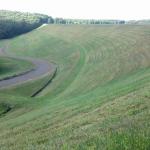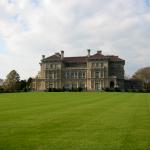Turf Maintenance Levels: Stress and Expectations
We often hear the terms ‘low maintenance’ and ‘high maintenance’ used in reference to turf management programs or specific turf sites, but what do these terms really mean? Furthermore, how does one go about modifying the level of management attention that is required to produce acceptable results?
Every turf management program requires specific inputs which include time, labor, and resources such as water, fertilizer, pesticides, budget, equipment, etc. From a fundamental standpoint, higher maintenance turf requires more in the way of inputs, and lower maintenance turf requires less. Maintenance needs are very closely tied to the amount of stress that exists in the growing environment, as well as the the expectations for turf performance.
Stress
Stress is one of the primary ingredients that has bearing on required maintenance levels for turf. Just like people or animals, plants are susceptible to detrimental effects from stress. One way to define plant stress is any agent that forces a plant to devote resources away from growth in order to combat the stress or its effects. Stress can be caused by a wide range of factors including pests, weather, soil conditions, plant competition, turf use, and management practices. When the growing environment is stressful, there is a greater need to ‘assist’, or intervene, with inputs, pest control measures and/or cultural practices… thereby increasing maintenance.
We have a great deal of control over some potential stress factors (e.g. mowing height), while for others we are able to exert very little control (e.g. heat). Examples of some common stress factors are as follows:
|
Management Practices |
Environmental Factors |
Site-Specific Factors |
|---|---|---|
|
|
|
Expectations for Turf Performance
Another main element that influences maintenance levels is the expectations for turfgrass performance. While the basic survival of turf cover is a fundamental goal and receives a large share of the priority for lower maintenance situations, additional practices designed to maintain a certain level of performance come into play in higher maintenance programs. For example, while lower maintenance programs may allow for natural dormancy, many other programs irrigate throughout the summer in order to maintain turf growth and color.
Turf performance forms the basis of expectations: each management situation has a certain level of performance that is expected by the users, owners, and/or maintainers of that turf. Turf performance has two basic components: aesthetics and function. Aesthetics refers to the visible appearance of the turf, in essence the ornamental value. Function is more about the utilitarian attributes of the turf, such as playability, slope stabilization or runoff reduction.
Simply put, performance = aesthetics + function. Expectations vary widely, of course, and each individual management scenario may place different priority on each of the two components of turf performance:
- Example #1, a high-end private golf course: aesthetics and function are likely both top priorities. Such sites are managed for maximum playability, and are simultaneously expected to be green and manicured in appearance.
- Example #2, an earthen dam: appearance takes a solid back seat in favor of efforts to ensure that a hardy, perennial cover is in place to minimize the potential for adverse runoff or soil erosion.
- Example #3, a low-traffic historic mansion lawn: in this case, maintenance to achieve visually attractive turf that complements the landscape and architecture takes precedence over functional considerations such as wear tolerance.
In general, the higher the desired level of performance, the greater the required inputs in terms of time, labor, irrigation, fertilization and other cultural practices. Key goals for most modern turf management programs are to achieve the expected performance level with a minimum of input and environmental impact. Factors that influence the ability to attain these goals include the use of the turf, turf species and cultivars present on the site, and the prevailing soil and environmental conditions. Many programs also employ particular variations on this theme. For example, IPM-based programs seek to achieve an expected performance level while minimizing pesticide use. Organic management programs strive for desired performance without the addition of synthetic fertilizers or pesticides into the system.
Certain functional aspects of different turfgrass species and varieties may aid the turf manager in reducing inputs in order to meet specific management objectives. For example, grasses with lower consumptive water use rates may perform better under drought conditions, while at the same time conserving irrigation water. Endophytic grasses may reduce damage from surface feeding insects, and in turn reduce the need for insecticide applications.
Bringing it Together
Expectations and certain stress factors, furthermore, are typically interrelated. A great example of this relationship involves golf course putting greens. Greens are typically maintained at a very low mowing height in order to provide a suitable playing surface. The very low mowing height and constant defoliation for greens minimizes the amount of leaf area available for photosynthesis. Lower photosynthetic capacity translates to a smaller root system which is less able to capture moisture and nutrients from the soil. Turfgrass plants under such stressful conditions, therefore, are less able ‘to provide for themselves’. The turf, in turn, is much more demanding in terms of careful watering and precision fertilization, and is much more likely to fail when environmental stresses, pests, or use-related challenges upset the delicate balance.
A large part of lowering maintenance demands and reducing inputs, then, is about managing stress and also expectations. In many ways it is more straightforward to deal with stress factors that we can directly control, such as mowing height, mowing frequency, pH, or timing of other cultural practices. Such practices, however, are often linked to expectations and may therefore necessitate ongoing dialog with customers, clients, or others users of the turf. Such conversations are typically more productive if there is a common goal to reduce maintenance.
Management of stresses that we can't control is promoted by better adaptation of the grasses present to specific stress factors, thereby promoting better equilibrium with the growing environment. Careful turfgrass selection has the biggest impact at the time of planting, and in the case of existing turf may require an investment in renovation or re-construction in order to realize benefits over the long term. Other approaches that support lower maintenance include reducing inputs such as fertilizer and water to the lowest level required to maintain the desired turf performance, integrated management of pests to reduce pesticide use, and investment of limited time and resources in key activities that pay future dividends (renovation or overseeding, for example). At the same time, it never hurts to always be prepared to shift priorities temporarily to deal with unforeseen, extenuating circumstances.


